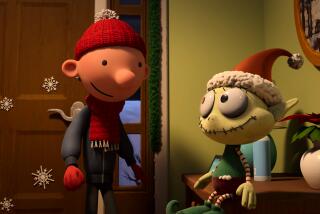TALES FROM THE CRIB
- Share via
As the former senior story editor of “Rugrats,” I was naturally delighted to see your cover story on the show (“Talk About a Baby Boom,” by Paul Brownfield, Aug. 16). I was even more delighted to see that, for once, Paul Germain received due credit as a main creative force behind the series.
I’m sorry that so much of your article was devoted to behind-the-scenes squabbling on the show. Sure, the writers had some creative differences with Arlene Klasky and Gabor Csupo, and all of us together, as usual, had to battle the inexhaustible determination of network executives to make sure that nothing funny, intelligent or different ever gets on the air.
“Rugrats” may have been what is termed a “writer-driven” show, but its charm derives in large part from the distinctive Klasky Csupo art style (there was a reason Paul chose this studio over numerous competitors to produce “The Simpsons”), and the quality of the finished product was the result of hard work and artistry in every phase of the animation process. Finally, of course, it took courage and vision on the part of the people at Nickelodeon to put “Rugrats,” “Ren & Stimpy” and “Doug” on the air at a time when most kids’ cartoons were cheap, dull and stupid.
It bugs me that “auteurs” like John Kricfalusi take every opportunity to slam animation writers, when it should be obvious that the best results come when artists and writers work together with mutual respect instead of being at each other’s throats.
PETER GAFFNEY
Cedar Glen
*
I read with rising hackles the flip comments by “Ren & Stimpy” creator John Kricfalusi about writers of animated TV programs.
Kricfalusi claims that animation does not draw the “best and brightest” writers; that animation studios do not use “actual writers” but rather “a [production assistant], or [somebody’s] girlfriend” to produce teleplays for animation. He says, “I talk to cartoonists every day who have to work from scripts, and they’re all on the verge of suicide.” These are hackneyed myths about animation writers that I’m tired of seeing put forth as fact.
For Kricfalusi to label animators and storyboarders “artists” while calling writers “production assistants” is hubris of the highest order. Animation writing is an unusually difficult craft, requiring a certain visual as well as a verbal sense. Many feature writers and sitcom writers have failed at the task. And believe me, for every cartoonist who contemplated suicide at being handed a writer’s script, there is a writer who considered hara-kiri after seeing a well-constructed story shredded to ribbons by a misguided storyboard artist.
Kricfalusi cites Walt Disney as saying cartoons are “made by artists with a sense of story.” Perhaps. But even during Disney’s lifetime, “story men” at Disney and Warners worked closely with artists to create compelling cartoons. It happens rarely in television animation today, but ideally writers and artists should work together. Each has an essential skill to bring to the medium.
Kricfalusi never recognized this, which is perhaps why “Ren & Stimpy” ran out of story ideas after two or three episodes and why his new work is consigned to the Spumco Web page.
JESS WINFIELD
Hollywood
Winfield is a writer and story editor at Walt Disney Television Animation.
More to Read
The complete guide to home viewing
Get Screen Gab for everything about the TV shows and streaming movies everyone’s talking about.
You may occasionally receive promotional content from the Los Angeles Times.






